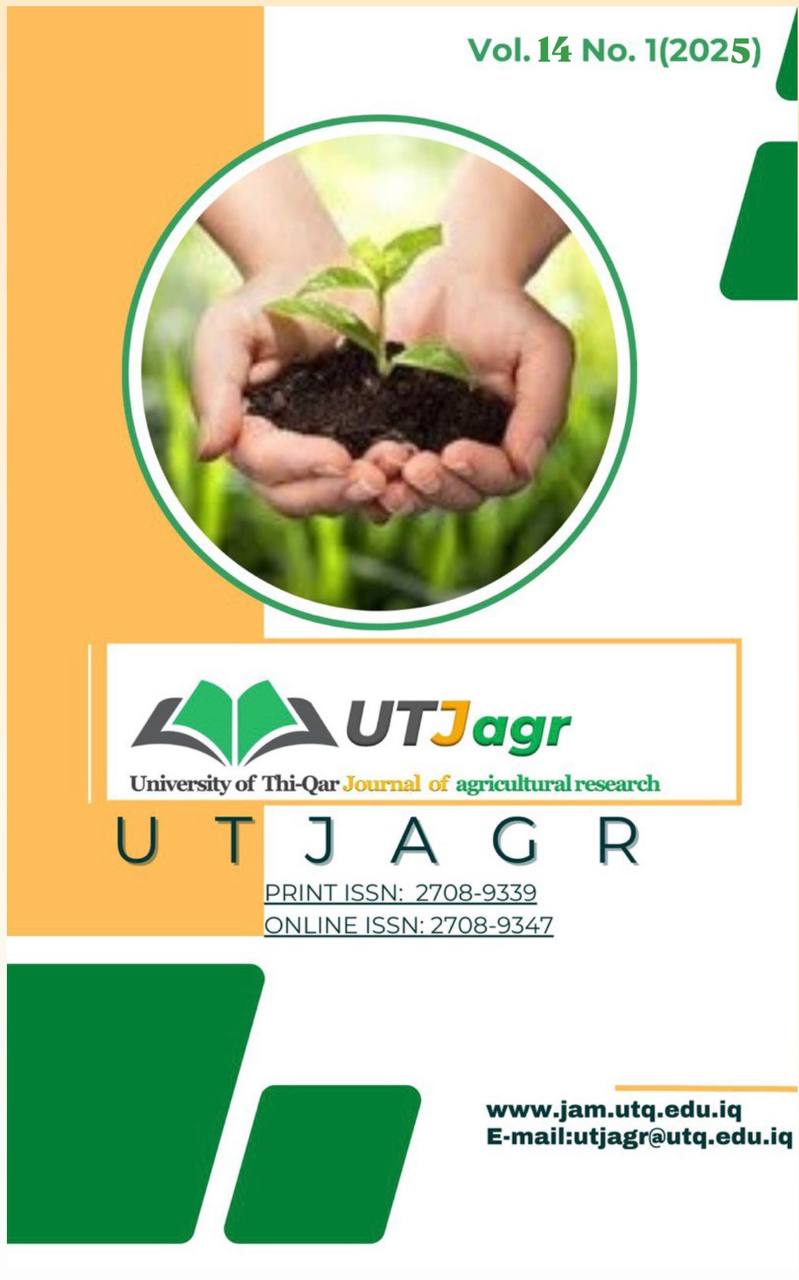Impact of the Number of Harrowing Times on Draft Force, Soil Fragmentation, and Bulk Density under Different Forward speeds and Depths
DOI:
https://doi.org/10.54174/2scbej38Keywords:
disk harrow, harrowing times, fragmentation indexAbstract
A field experiment was conducted in one of the fields of the Faculty of Agriculture, Karma Ali site, on clay soil, according to a Randomized Complete Block Design (RCBD). The plowing process was performed with a disk plow and harrowing with a disk harrow once, twice, and three times, while the plowing depth of 15, 20, and 25 cm, and the forward speed levels of 2.58, 4.03 and 5.57 km h-1. The results showed that the draft force required by the disk plow used in the plowing process was higher than the traction force required by the draft ged disk harrow used in the harrowing process by a percentage of 10.11, 10.87, and 11.67% in the case of harrowing once, twice, and three times, respectively. The traction force also decreased with increasing harrowing times, as when Increasing the tillage from once to twice and three times decreased the draft force by 15% and 32% respectively. The number of tillage times, once, twice and three times, was significantly superior in reducing the values of the crumbling index and apparent density compared to the plowing process, as the plowing process recorded the highest draft force and the highest values of the crumbling index and apparent density of 14.95 kN, 42.02 mm and 1.35 Mg m-3 respectively. The results also showed the significant interaction between the tillage and the plowing depth in reducing the draft force, crumbling index and apparent density compared to the plowing process. The lowest crumbling index and lowest draft force were at a depth of 15 cm and three times of 14.76 mm and 2.89 kN respectively. The lowest apparent density was 1.09 g.cm-3 at a depth of 15 cm and two times of harrowing. As for the interaction between the plowing and harrowing process and the forward speed, the speed was recorded The forward speed of 2.58 km h-1 and the three-time harrowing operation recorded the lowest draft force of 2.96 kN and the lowest pulverization index at a forward speed of 5.57 km h-1 and three-time harrowing operations of 15.39 mm. The forward speed of 15.57 km h-1 and two-time harrowing operations recorded the lowest apparent density of 1.07 Mg m-3.
Downloads
References
Aday, S. H., Aldosary, S. H., & Hassan, J. C. (2011). The effect of the tractor-implement passes on the soil penetration resistance of plowed silty clay soil. Basrah Journal of Agricultural Sciences, 24(1), 2011.
Ahaneku, I. E., & Ogunjirin, O. A. (2005). Effect of tractor forward speed on sandy loam soil physical conditions during tillage. Nigerian Journal of Technology, 24(1), 51–57.
Aikins, K. A., Antille, D. L., Jensen, T. A., & Blackwell, J. (2021). Influence of tillage speed and depth on soil physical properties and cotton emergence. Biosystems Engineering, 204, 1-12. https://doi.org/10.1016/j.biosystemseng.2021.01.013
Al aridhee, J., & Al Sabagh, A. (2011). Effect of tractor type, speed, and tillage depth on some technical indicators of machine units and physical characteristics of the soil (Master’s thesis, University of Baghdad).
Al-Lami, A. M., Y. K. Al-Timimi, and H. K. Al-Shamarti. 2021. Spatiotemporal analysis of some extreme rainfall indices over Iraq (1981–2017). Scientific Review Engineering and Environmental Studies (SREES), 30(2): 221-235.
Alwan, A. A. (2019). A Field Study of Soil Pulverization Energy by using Different Moldboards Types Under Various Operating Condition. Basrah Journal of Agricultural Sciences, College of Agriculture, University of Basrah, 32, 373–388. https://doi.org/10.37077/25200860.2019.284
Amer, K. Z., & Muter, S. A. (2023). The impact of two types of tillage machines on the tillage dates and numbers of durum wheat, Triticum durum yield (Waha Iraq). International Journal of Agricultural & Statistical Sciences, 19(1), 231–237. https://doi.org/10.59467/IJASS.2023.19.231
Amer, K. Z., & Swain, K. H. (2021). The impact of plowing depth and soil moisture on some technical indicators at using disk plow. International Journal of Agricultural & Statistical Sciences, 17(1). https://doi.org/10.1016/j.still.2021.105202
Amin, M., Khan, M. J., Jan, M. T., Rehman, M. U., Tariq, J. A., Hanif, M., & Shah, Z. (2014). Effect of different tillage practices on soil physical properties under wheat in semi-arid environment. Soil Environ, 33(1), 33-37.
Balsari, P., Biglia, A., Comba, L., Sacco, D., Alcatrao, L. E., Varani, M., ... & Aimonino, D. R. (2021). Performance analysis of a tractor-power harrow system under different working conditions. Biosystems Engineering, 202, 28-41.https://doi.org/10.1016/j.biosystemseng.2020.11.009
Black, C.A.; Evans, D.D.; White, J.L.; Ensminger, L.E. & Clarck, F.E. (1965). Methods of Soil Analysis. Part 1. Physical Properties. Am. Soc. Agron. Inc. Pub., Madison, Wisconsin, 770pp.
Chen, Y., Tessier, S., & Rouffignat, J. (2020). Soil bulk density and porosity under different tillage systems. Soil Science Society of America Journal, 59(3), 724-731. https://doi.org/10.2136/sssaj1995.03615995005900030015x
Godwin, R. J., O’Dogherty, M. J., Saunders, C., & Balafoutis, A. T. (2007). A machine for assessing the mechanical properties of soil. Journal of Agricultural Engineering Research, 76(2), 161-171. https://doi.org/10.1006/jaer.2000.0538
Hillel, D. (1980). Fundamentals of Soil Physics. Academic Press Inc. New York, U.K.
Isaak, M., Azawi, A., & Turky, T. (2024). Influence of various tillage systems and tillage speed on some soil physical properties. Progress in Agricultural Engineering Sciences, 20(1), 37-47. https://doi.org/10.1556/446.2024.00070
Khan, S., Shah, A., Nawaz, M., & Khan, M. (2017). Impact of different tillage practices on soil physical properties, nitrate leaching and yield attributes of maize (Zea mays L.). Journal of soil science and plant nutrition, 17(1), 240-252. http://dx.doi.org/10.4067/S0718-95162017005000019
Kheiralla, A. F., Yahya, A., Zohadie, M., & Ishak, W. (2004). Modelling of power and energy requirements for tillage implements operating in Serdang sandy clay loam, Malaysia. Soil and Tillage Research, 78(1), 21-34. https://doi.org/10.1016/j.still.2004.02.006
McGarry D, Bridge B J & Radford B J (2000). Contrasting soil physical properties after zero and traditional tillage of an alluvial soil in the semi-arid subtropics. Soil and Tillage Research 53(2): 105-115
Meselhy, A. A. E. (2021). Effect of variable-depth tillage system on energy requirements for tillage operation and productivity of desert soil. International Journal of Applied Agricultural Sciences, 7(1), 38. DOI:10.11648/j.ijaas.20210701.13
Mouazen, A. M., & Ramon, H. (2006). Development of on-line measurement system of bulk density based on on-line measured draught, depth and soil moisture content. Soil and Tillage Research, 86(2), 218-229. https://doi.org/10.1016/j.still.2005.02.028
Nassir A.J (2014). Requirements of pulverization Energy of a tandem Disk Harrow At different . Pulverization depth And forward speed Basrah J. Agric. 27(1):301-315.
Nassir, A. J., Ramadhan, M. N., Alwan, A. A., & Muhsin, S. J. (2024). Optimisation and Modelling of Soil Pulverisation Index Using Response Surface Methodology for Disk Harrow Under Different Operational Conditions. Acta Technologica Agriculturae, 27(2), 76–83. https://doi.org/10.2478/ata-2024-0011
Nassir, A. J., S. J. Muhsin, A. A. Mishall, and F. M. Almusawi. 2023. The impact of the tillage systems on input-output energy, soil pulverization, and grain yield of barley. Agricultural Engineering International: CIGR Journal, 25(4): 68-83.
Okoko, P. (2022). Draft Force Determination for an Offset Disk Harrow in a Sandy Loam Soil. Adeleke University Journal of Engineering and Technology, 5(2), 140-146. DOI:10.4314/jasem.v25i5.9
Roger-Estrade, J., Anger, C., Bertrand, M., & Richard, G. (2010). Tillage and soil ecology: partners for sustainable agriculture. Soil and Tillage Research, 111(1), 33-40. https://doi.org/10.1016/j.still.2010.08.010
Sadek, M. A., Chen, Y., & Zeng, Z. (2021). Draft force prediction for a high-speed disk implement using diskrete element modelling. Biosystems engineering, 202, 133-141.https://doi.org/10.1016/j.biosystemseng.2020.12.009
Soane, B. D., Ball, B. C., Arvidsson, J., Basch, G., Moreno, F., & Roger-Estrade, J. (2012). No-till in northern, western and south-western Europe: A review of problems and opportunities for crop production and the environment. Soil and Tillage Research, 118, 66-87. https://doi.org/10.1016/j.still.2011.10.015
Wang, Y., Jin, Y., Liang, X., Liu, X., Tan, B., He, S., ... & Zhang, Y. (2022). Fragmentation of soil-root complexes in sloping landscapes during tillage and soil translocation. Biosystems Engineering, 223, 116-128.https://doi.org/10.1016/j.biosystemseng.2022.08.014
Zhang S, Grip H & Lövdahl L (2006). Effect of soil compaction on hydraulic properties of two loess soils in China. Soil and Tillage Research 90(1-2): 117-125

Downloads
Published
Issue
Section
License
Copyright (c) 2025 aabas aali

This work is licensed under a Creative Commons Attribution-NonCommercial-ShareAlike 4.0 International License.







1.png)

